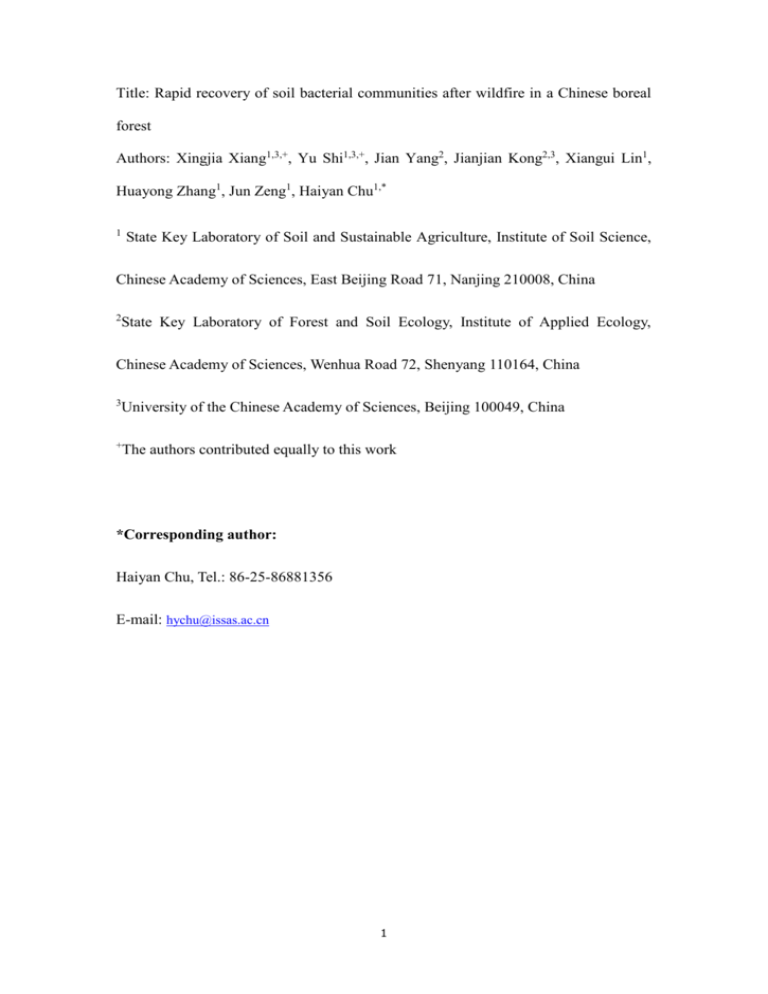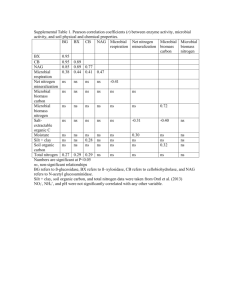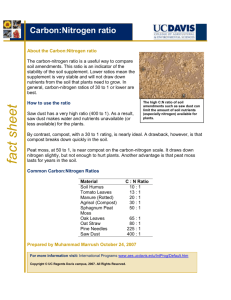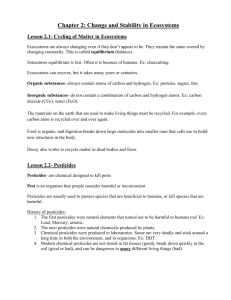Title: Rapid recovery of soil bacterial communities after wildfire in a
advertisement

Title: Rapid recovery of soil bacterial communities after wildfire in a Chinese boreal forest Authors: Xingjia Xiang1,3,+, Yu Shi1,3,+, Jian Yang2, Jianjian Kong2,3, Xiangui Lin1, Huayong Zhang1, Jun Zeng1, Haiyan Chu1,* 1 State Key Laboratory of Soil and Sustainable Agriculture, Institute of Soil Science, Chinese Academy of Sciences, East Beijing Road 71, Nanjing 210008, China 2 State Key Laboratory of Forest and Soil Ecology, Institute of Applied Ecology, Chinese Academy of Sciences, Wenhua Road 72, Shenyang 110164, China 3 University of the Chinese Academy of Sciences, Beijing 100049, China + The authors contributed equally to this work *Corresponding author: Haiyan Chu, Tel.: 86-25-86881356 E-mail: hychu@issas.ac.cn 1 Table S1: Summary of the main characteristics of sampling sites in the Greater Khingan Mountains. The values in brackets represent the standard deviation of the mean. Different letters represent significant differences from Tukey’s HSD comparisons (P < 0.05). OL: one year after low intensity fire; OH: one year after high intensity fire; EL: 11 years after low intensity fire; EH: 11 years after high intensity fire. SM: soil moisture; TC: total carbon; TN: total nitrogen; C/N: carbon/nitrogen; DOC: dissolved organic carbon; DON: dissolved organic nitrogen; MBC: microbial biomass carbon; MBN: microbial biomass nitrogen. Soil variables control OL OH EL EH Soil pH 4.1 (0.11) 4.8 (0.19) 4.6 (0.13) 4.4 (0.15) TC (%) a a a a TN (%) C/N ratio SM (%) AP (mg/kg) + NH4 (mg/kg) - NO3 (mg/kg) DOC (mg/kg) DON (mg/kg) MBC (mg/kg) MBN (mg/kg) Elevation (m) b a 8.9 (1.4) a 8.9 (2.2) a 0.38 (0.05) a 6.9 (1.1) a 0.45 (0.09) b 23 (0.9) 20.3 (1.5) 29.4 (3.7) c a 34 (2.1) 0.51 (0.21) 11.4 (4.5) ab 440 (118) a a 133 (37) 2993 (447) a 532 (93) b 885 (41) 566 (100) b 199 (67) ab 961 (48) 2 7.5 (2.5) 288 (24) 32 (2)c 1.1 (0.3)b ab 352 (22)ab 404 (36) a 72 (5)a 105 (22) b b 489 (70) 1210 (204) b 112 (35) 1007 (52) 1048 (133)b b 113 (19)b ab 948 (39)ab 187 (61) a 23.8 (1.2)b ab 5.6 (1.7) b 107 (20) b 25.4 (1.6) 43 (7) a a 132 (25) a ab bc 58 (8) a a 490 (40) 26.8 (2.8) ab 64 (11) b 68 (6)ab 80 (12) ab 0.36 (0.04)a 22 (0.7)ab ab 55 (6) a 0.42 (0.06) 20 (1.2) b 56 (6) b a b 20 (1.2) b 86 (12) 0.33 (0.04) 4.3 (0.16)ab 7.9 (0.8)a 8.2 (1.1) a b 19 (1.1) a ab 967 (51) Table S2: Relative average abundances of phyla classified with RDPII taxonomy across all soils and soils grouped into different treatments (values represent % of total sequences). Asterisks indicate sequences classified to the domain Bacteria, but not to a specific phylum. The “0.00” value means less than 0.01. OL: one year after low intensity fire; OH: one year after high intensity fire; EL: 11 years after low intensity fire; EH: 11 years after high intensity fire. Taxon Alphaproteobacteria Actinobacteria Acidobacteria Bacteria* Betaproteobacteria Bacteroidetes Gammaproteobacteria Proteobacteria;Other Planctomycetes Chloroflexi Deltaproteobacteria Gemmatimonadetes Firmicutes AD3 Armatimonadetes Verrucomicrobia WPS-2 Cyanobacteria Elusimicrobia TM6 SC3 Crenarchaeota Chlorobi Nitrospirae CCM11b TM7 OP3 SC4 SM2F11 Thermi SPAM Chlamydiae WS3 Euryarchaeota OP11 NC10 BRC1 ALL 21.56 17.74 15.16 14.54 8.45 7.46 4.28 1.87 1.73 1.24 1.19 0.81 0.82 0.39 0.37 0.29 0.28 0.27 0.10 0.09 0.08 0.08 0.07 0.03 0.03 0.03 0.02 0.02 0.02 0.01 0.01 0.01 0.01 0.01 0.00 0.00 0.00 Control 25.40 17.76 19.48 15.71 4.62 3.87 4.61 1.70 1.90 0.90 1.33 0.62 0.46 0.26 0.16 0.17 0.16 0.09 0.08 0.08 0.08 0.09 0.07 0.01 0.02 0.01 0.02 0.01 0.01 0.01 0.01 0.01 0.01 0.00 0.00 0.00 0.00 OL 20.24 19.80 9.52 11.55 13.46 11.13 4.15 2.03 1.07 1.32 0.72 0.80 1.23 0.44 0.50 0.21 0.45 0.28 0.07 0.04 0.08 0.02 0.07 0.01 0.01 0.02 0.01 0.02 0.00 0.04 0.00 0.00 0.00 0.00 0.00 0.00 0.00 3 OH 21.38 16.33 11.22 11.76 13.01 12.08 4.39 2.12 1.25 0.76 0.94 0.73 0.95 0.38 0.70 0.30 0.31 0.24 0.05 0.09 0.07 0.02 0.05 0.01 0.00 0.02 0.02 0.02 0.02 0.03 0.00 0.00 0.00 0.00 0.00 0.00 0.00 EL 20.36 18.50 14.74 17.85 6.30 5.38 4.15 1.96 2.10 1.87 1.44 1.06 1.06 0.41 0.23 0.43 0.17 0.37 0.17 0.09 0.08 0.13 0.08 0.05 0.06 0.04 0.03 0.02 0.03 0.00 0.01 0.03 0.01 0.01 0.01 0.01 0.00 EH 20.40 16.30 20.86 15.84 4.83 4.83 4.07 1.56 2.33 1.37 1.54 0.83 0.40 0.45 0.24 0.34 0.32 0.35 0.13 0.13 0.09 0.13 0.09 0.07 0.06 0.04 0.03 0.03 0.04 0.00 0.04 0.02 0.02 0.02 0.00 0.00 0.00 Table S3: Differences of bacterial communities across the different groups examined by the dissimilarity test of ANOSIM. Pearson correlations coefficients (r) are shown with associated Bonferroni-corrected P-value. P < 0.05, significant convention. OYF: 1 year post fire; EYF: 11 years post fire. Control-OYF Control-EYF OYF-EYF r 0.53 0.02 0.49 4 P 0.001 0.549 0.001 Table S4: Correlations between the relative abundances of the dominant bacterial phyla and soil characteristics and altitude by linear regression analyses. Pearson correlations coefficients (r) are shown for each taxon with associated Bonferronicorrected P-value. SM: soil moisture; TC: total carbon; TN: total nitrogen; C/N ratio: carbon/nitrogen ratio; AP: available phosphorus; DOC: dissolved organic carbon; DON: dissolved organic nitrogen; MBC: microbial biomass carbon; MBN: microbial biomass nitrogen. r value Alphaproteobacteria pH -0.419** TC (%) TN (%) C/N ratio SM (%) AP (mg/kg) DOC (mg/kg) DON (mg/kg) 0.135 0.071 0.071 -0.086 -0.118 Actinobacteria ** 0.586 0.245 * Acidobacteria -0.574** -0.064 Betaproteobacteria ** 0.303 -0.234 0.037 -0.240 NO3(mg/kg) -0.092 MBN Elevation (mg/kg) (m) 0.380* 0.011 0.440** -0.010 -0.248 0.252 0.144 0.133 0.199 0.207 0.311 0.490** 0.052 -0.251 -0.444** -0.470** 0.231 0.049 -0.265* 0.243 ** 0.392* 0.230 -0.409** -0.113 0.016 -0.433** 0.198 -0.267* 0.197 0.029 -0.049 0.225* ** * -0.162 0.009 -0.635 -0.079 Bacteroidetes -0.082 -0.012 -0.187 Gammaproteobacteria -0.391** -0.184 -0.212 -0.282* 0.058 Planctomycetes -0.284* 0.026 -0.064 Chloroflexi 0.518** -0.166 0.362** 0.129 0.463** 0.001 0.309* -0.173 0.509** 0.245 0.201 -0.223 0.240 0.482 -0.135 0.152 -0.260* 0.021 0.208 -0.078 -0.184 0.328* -0.230 0.114 0.128 -0.102 -0.424** 0.536** 0.195 0.154 0.026 -0.119 0.213* 0.095 -0.193 *: P < 0.05; **: P < 0.01, significant convention 5 * MBC (mg/kg) -0.073 0.377 0.191 Deltaproteobacteria NH4+ (mg/kg) -0.118 -0.213 0.170 0.234 -0.007 0.103 0.407** -0.393* -0.178 -0.089 -0.169 -0.050 -0.289* -0.333* 0.188 -0.071 0.102 Table S5: Pearson correlations (R) between bacterial diversity (Faith’s PD, OTUs) and soil and site characteristics by linear regression analyses. SM: soil moisture; TC: total carbon; TN: total nitrogen; C/N ratio: carbon/nitrogen ratio; AP: available phosphorus; DOC: dissolved organic carbon; DON: dissolved organic nitrogen; MBC: microbial biomass carbon; MBN: microbial biomass nitrogen. Soil variables pH r value OTUs PD * 0.298 * 0.197 TC (%) 0.322 0.228 TN (%) 0.248 0.174 C/N ratio 0.126 0.107 SM (%) 0.247 0.204 AP (mg/kg) 0.121 0.104 NH4+ (mg/kg) 0.126 -0.139 NO3- (mg/kg) 0.021 -0.040 DOC (mg/kg) 0.270 * 0.257 * DON (mg/kg) 0.026 -0.049 MBC (mg/kg) 0.194 0.136 MBN (mg/kg) 0.054 0.011 Elevation (m) -0.268 * -0.220 *: P < 0.05, significant convention 6 Figure S1: Relative abundances of the dominant bacterial phyla in soils. Relative abundances are based on the proportional frequencies of DNA sequences that could be classified at the phylum level. OL: one year after low intensity fire; OH: one year after high intensity fire; EL: 11 years after low intensity fire; EH: 11 years after high intensity fire. 7 Figure S2: OTUs that exhibited significant changes in abundance at one year after low intensity fire. Significance was determined using response ratio methods at a 95% CI (confidence interval). 8 Figure S3: Canonical correspondence analysis (CCA) of the bacterial communities was completed in the vegan package of R v.2.8.1 project. SM: soil moisture; TN: total nitrogen; C/N ratio: carbon/nitrogen ratio. 9 Figure S4: The relationships between relative abundances of dominant bacterial groups and soil pH. Linear regressions were used to test the correlation between the taxa’s relative abundances and pH. P < 0.05, significant convention. 10








